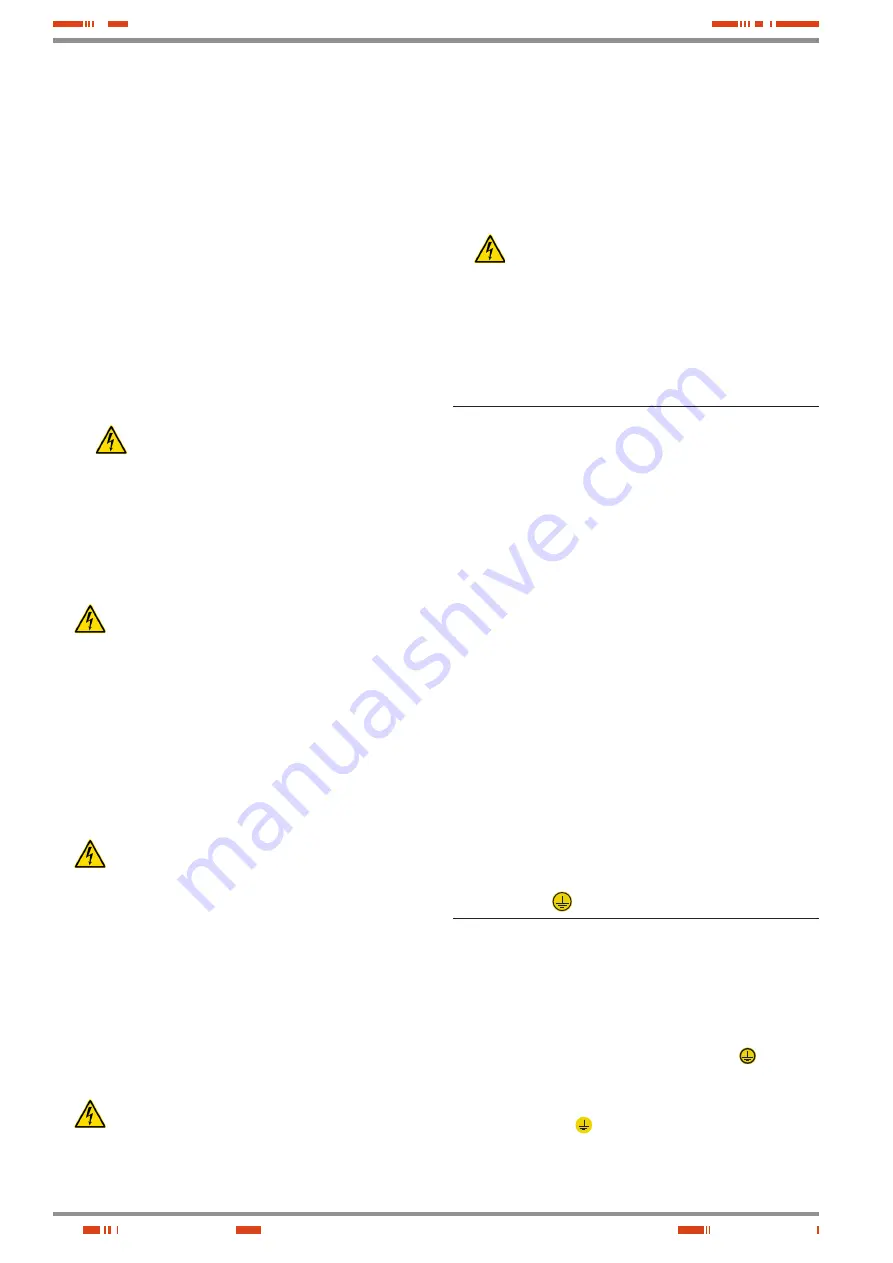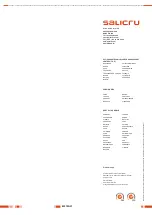
18
When the protection consists of fuses, these are supplied
already inserted into the fuse holder base, as the batteries
themselves are not delivered already installed in the cabinet.
This way, any loss or mislaying is avoided.
•
The batteries are always supplied in packaging separate to
the device cabinet or accumulator cabinet or cabinets. Con-
sequently, it will be necessary to install and connect them
according to the connection diagram supplied with the docu-
mentation, using the accessories provided, such as strips,
cables and screws.
Start the process by placing the batteries in the lower tray to
secure the cabinet, ensuring that the centre of gravity is as
low as possible, and work your way up as the trays are filled.
•
In systems with removable trays, it is advisable to insert
them as they fill up, thus avoiding unnecessary mechanical
stresses on the frame itself, which can lead to structural tor-
sion.
To remove each battery tray, it is necessary to remove
the two screws
that fix it like a mechanical lock located
on either side of the front.
Wait until the end to connect the end cables be-
tween levels, otherwise there is a risk of electric
shock.
Fill up the trays with the accumulators one by one, inter-
connect the batteries between them and insert each tray
as individual tasks are completed on each of them.
Fit the two screws
which act as a lock and tighten them.
Then connect the batteries between levels, observing
the safety instructions indicated in this document and in
EK266*08.
•
Dangerous voltages stored in batteries
: Precau-
tions must be taken with the batteries once intercon-
nected, as there may be dangerous voltage between the
terminals of different batteries or between one of them and
the earth, depending on the total voltage of the bank, in-
cluding when the device is disconnected.
•
In systems with 0/ or 0A/ backup, the acquisition, installation
and connection of batteries will always be carried out
under
the responsibility
of the customer. Information concerning
the batteries in terms of number, capacity and voltage is indi-
cated on the battery label affixed next to the device’s name-
plate.
Strictly observe
this information, the connection
polarity of the batteries and the connection diagram supplied
with the documentation and the DC Power-L.
•
Any handling and connection of the batteries should
only be carried out or supervised by
suitably quali-
fied personnel
.
Before carrying out any action, disconnect the batteries.
Check that no current is present and that there is no dan-
gerous voltage at the ends of the terminals of the battery
bank.
The battery circuit is isolated from the input voltage of devices
with floating output voltage, but not from devices with output
voltage referenced to earth. Dangerous voltages can occur
between the terminals of the battery bank and the earth.
Check that the system does not have input voltage before
working on the batteries, otherwise the rectifier will supply
DC voltage to the cables connected to the accumulator bank,
with the resultant risk.
•
It should never be forgotten that the DC Power-L with
batteries is a generator of electrical power, regardless
of whether the batteries are installed in the same cabinet or in
the device itself, so the user must take all necessary precau-
tions against direct or indirect contact.
If the batteries are connected to the device and its protec-
tions are set to ‘On,’ it is irrelevant whether or not the DC
Power-L is connected to the power supply, as is the state or
position (On or Off) of its protection.
The output terminals will supply voltage while the battery
bank has power, unless the output disconnector switch
(Q2)
is ‘Off’ or, if there is output distribution, the general protection
of the output distribution or each of the individual output dis-
tribution protections is set to ‘Off.’
•
Dangerous voltages stored in capacitors
:
Precau-
tions must be taken as charged capacitors with dan-
gerous voltages may be installed between the connection
terminals or between one of them and earth, even when the
device is switched off. Wait 30 seconds or more to allow
these to discharge.
7.2. Considerations to take into
account.
•
The location should be spacious, airy and easily accessible.
The slots of the ventilation should never be obstructed, nor
should the device be installed outdoors.
•
The cross sections of the input, output and earth cables must
be in accordance with the rated current indicated on the
nameplate, and compliance with the country’s regulations
and legislation is an essential requirement.
•
A bad connection or operation can cause faults in the device
and/or the loads connected to it. Read the instructions in this
manual carefully and follow the steps indicated in the order
established.
•
The base of the cabinet features a number of wall bushings
(cable glands, Fig. 2), to isolate the routing of the connection
cables through the metal sheet of the cabinet.
Cut them to the appropriate section to enable the respec-
tive input, output and battery cables to pass through them in
models with the accumulators in a separate cabinet.
Upon request, some cabinets can have a slot to serve as a
conduit for cable entry, instead of the wall bushings.
•
All of the cables will be fixed to the bar by clips in order to im-
mobilise them and prevent possible pulling that could lead to
false contacts, cable disconnection, etc., and consequently,
to failures of the device and/or possible accidents due to
electric shock.
7.3. Earth connection, terminal or
strip .
•
It is advisable,
and so required by
the regulations or legisla-
tion of the country, to
connect the device to earth
.
Make sure that all of the device’s loads are only connected
to earth in the form of a terminal or strip. Failure to limit the
earthing of the loads to this
single point
would create earth
return loops and degrade the quality of the power supplied.
All terminals identified as an earth connection
( )
are linked
together and to the earth of the cabinet.
•
For models with batteries in a separate cabinet, connect
the terminal or strip
of the earth of the rectifier, to the earth
bonding terminal
( )
of the accumulator cabinet, using the
cable provided in the battery connections hose.
USER MANUAL
Summary of Contents for DC POWER-L Series
Page 2: ...2 USER MANUAL...
Page 31: ...31 SALICRU...















































